INDIA
History

History

Cities in INDIA
| Bangalore | Mumbai |
Popular destinations INDIA
| Goa |
History
Indus culture and the arrival of the Aryans
Traces of human life on the Indian subcontinent go back about 40,000 years. Remains have been found from the Pleistocene and the Late Paleolithic (up to 30,000 years ago). Paintings at Bhimbetka near Bhopal are between 10,000 and 40,000 years old.
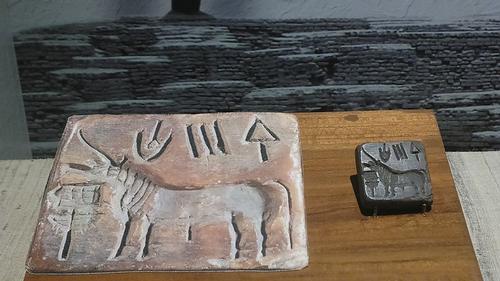 Seal Indus Culture, IndiaPhoto: Royroydeb CC 4.0 International no changes made
Seal Indus Culture, IndiaPhoto: Royroydeb CC 4.0 International no changes made
The Indus Valley was between 3000 and 1500 BC. the place where Indus culture (also called Harappa culture) flourished. It was an urban civilization with Lothal in Gujarat and Mohenjodaro and Harappa as main centers in modern-day Pakistan.
The cities were designed according to a system of straight streets and brick houses, and they also had a sewer and water supply system. The Indus civilization had a written language with pictograms and there was a lot of trade with neighboring countries.
From 1500 BC. Indus culture was attacked by Indo-Aryan groups and the area was colonized from the northwest. These groups are believed to have come from southern Russia or from Afghanistan. The middle and east of India were also captured and cities like Delhi and Benares arose during this period. These peoples mixed with the indigenous peoples under their rule, the caste system so typical of India was born. Also, the Vedas written in Sanskrit were written at this time, the sacred scriptures on which Hinduism is based.
The Aryan kingdoms were attacked by Alexander the Great between 327 and 324 BC. With a huge army, he conquered northern India and parts of Afghanistan and Pakistan; only southern India managed to resist him. Not until 274 BC. Ashoka, the grandson of Candragupta, managed to conquer the south. This battle went against the Kalingas and killed tens of thousands of civilians and soldiers. Shocked by this massacre, Ashoka converted to Buddhism and spread the religion to neighboring countries.
After his death, Ashoka's culturally advanced empire fell into disrepair. In 185 BC. the last ruler of the Maurya dynasty was killed and the empire fell into conflicting kingdoms. India's second important kingdom was Kushana, which had its heyday from the 1st century BC. until the 3rd century AD. It included Central Asia and Northern India and extended to Varanasi and Vaishali near Bhopal. The capitals were Peshawar (now in Pakistan) and Mathura. The greatest leader was the Buddhist convert Kanishka.
Gupta, Pallawa and Chola: the classic period
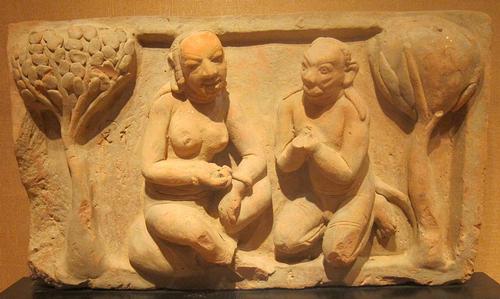 Scene from Ramayana Gupta period, IndiaPhoto: Hiart in the public domain
Scene from Ramayana Gupta period, IndiaPhoto: Hiart in the public domain
In the period 320-544, Northern India became a political unit and culture flourished. During this so-called Gupta period, Hinduism revived at the expense of Buddhism. The Gupta empire collapsed after 470 due to raids by Huns from Persia and Turkey and disintegrated into several empires. In the south, the battle between different Dravidian dynasties continued. The Pallawas controlled large parts of the south from the capital Kanchipuram, and in the 7th century and 8th century the Pallawa empire was at its peak.
Around 850, the empire was conquered by the Cholas, of whom Raja Raja I took the throne in 985. Under his rule, and that of Kulottunga I, the area of the Cholas extended to the north of Ceylon, Malaysia and parts of Sumatra. From about 1150 decay began and around 1250 the Chola empire was annexed by the Pandyas.
Islamists attack the north of India
The north was attacked by Muslims from Afghanistan from the beginning of the 11th century, and by 1192 the many kingdoms had fallen into the Islamic hands of Mohammed Ghur.After his death, he was succeeded by the general and ex-slave Qutb-ud-din, the sultan of Delhi. This slave dynasty was to rule the sultanate of Delhi until 1526, which covered most of northern India. Under the Tughluq Dynasty, the decay of the sultanate of Delhi began, and the area was conquered in 1398 by the ruthless conqueror Timur the Cripple (Timur-Lenk), the "scourge of God." In the south, Islam did not really gain ground and the Hindu kingdom of Vijayanagar had an exceptional flowering period of 1350-1550.
The empire of the moguls
The sultanate of Delhi was conquered in 1526 by the Turkuran Babur. At the Battle of Panipat, the last Delhi sultan, Ibrahim Lodi, was defeated, and the opposing warriors of the Rajpots were also defeated by Babur. At that time Baboer was the founder and first emperor of the Mughal Empire. This empire grew increasingly powerful until 1707, brought India more political unity, and caused a tremendous revival of all kinds of art.
Baboer's son Hoemayoen was defeated in 1540 by the Afghan ruler Sher Shah, but after his death in 1554 Hoemayoen returned. Hoemayoen was succeeded by his 13-year-old son Akbar, who did amazingly well, and was not only a good soldier but also an art lover. In the early 17th century, he controlled all of North India, under the leadership of his regent Bairam Khan. His empire was ruled by government officials and local princes who, when they submitted, retained their rights and sometimes even had higher positions. In this way Akbar ensured unity in his empire and even religious differences were tolerated. He even founded a new religion: the Divine Faith, more or less a mixture of all essential elements from Hinduism, Islam and Christianity.
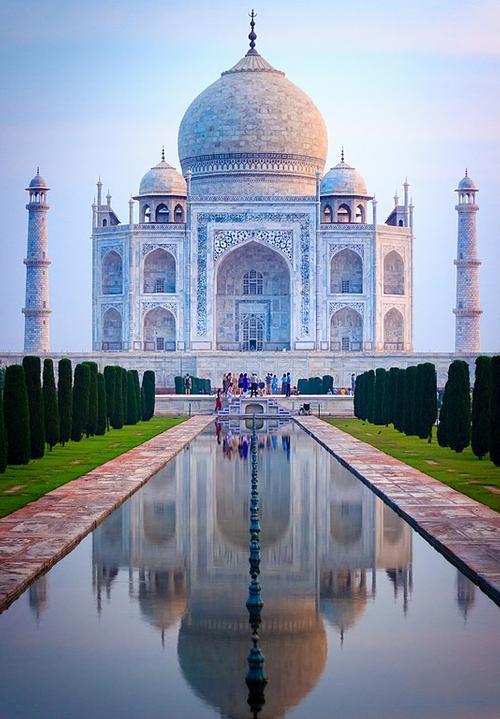 Taj Mahal IndiaPhoto: Malpaniashutosh CC 4.0 Internationalno changes made
Taj Mahal IndiaPhoto: Malpaniashutosh CC 4.0 Internationalno changes made
Akbar was succeeded by his son Jehangir who would rule until 1627. Jehangir was succeeded in that year by Shah Jahan, who further expanded the empire and boosted trade and economy. He also built the beautiful Taj Mahal in honor of his late wife.
In 1658, Shah Jahan was deposed by his son Aurengzeb. Under this monarch, the mogul empire reached its greatest extent, as large parts of southern India were also conquered. However, religious freedom was stopped under Aurengzeb and a period of Islamization followed with the persecution of infidels and the breaking down of Hindu temples. Rajpoeten and Marathen, both Hindu peoples, resisted violently, and together with the outbreak of a succession struggle and the increasing influence of Europe, the empire slowly collapsed.
European influences are spreading
The sea route to India via the Cape of Good Hope in South Africa had meanwhile been found in 1498 by the explorer Vasco da Gama. That same year, he landed on the southwest coast of India in Calicut, Kerala. After Goa was conquered in 1510, the Portuguese managed to maintain a trade monopoly in this region until the 17th century.
The other major seafaring nations also had their eyes on India. The Dutch established trading posts in South India, and the French owned several trading colonies in Pondicherry from 1672. The British East India Company gained most power and influence, with trading posts in Surat (1612), Chennai (1640), Mumbai (1688) and Calcutta (1690). Both the French and English companies were all involved in trade and did not interfere in domestic affairs.
Around 1750, the situation in India changed radically because of the problems between the great powers France and England in Europe. Self-interest was now paramount, and the battle between France and Britain peaked at the Battle of Plassey in Bengal (1757). The British defeated a huge Bangladeshi army supported by the French.
British supremacy
A hundred years later, about 60% of India's territory was under direct British control. The rest of the country was ruled by local monarchs and Maharajahs who had to recognize the sovereignty of the English.
In 1857 the Sepoy uprising, the "Mutiny", broke out, the first major uprising against the British rulers. Disaffected by British rule, the Sepoys, soldiers from the Indian regiments of the British Colonial Army, were supported by deposed Hindu princes and members of the Mogul dynasty. The uprising was crushed very harshly, and the government in Britain responded by handing over the government of a governor general in 1858, who was given the title of viceroy or "Raj." Queen Victoria then became Empress of India and the East India Company was completely ruled out. That same year, the last Mogul king, Bahadur Shah II, was deposed, bringing the Mogul empire to a definitive end.
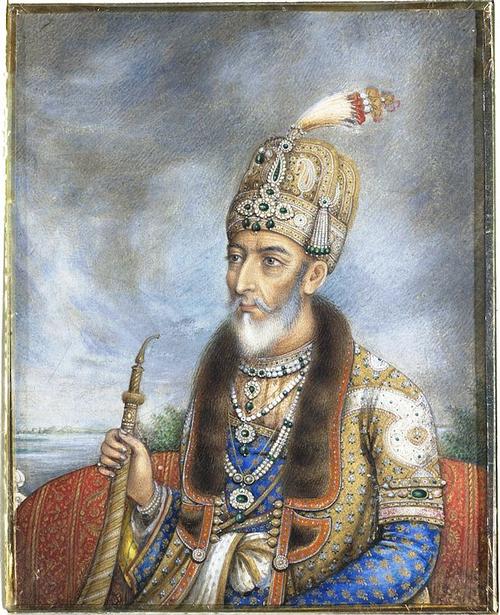 Bahadur Shah Zafar, IndiaPhoto: Public domain
Bahadur Shah Zafar, IndiaPhoto: Public domain
India was now part of the British Empire, with a viceroy as its chief administrator; the Indians were subjects of Queen Victoria. From 1840 to 1914, India was the main trading partner of the British, and the country received a fairly high degree of autonomy. In 1877, Queen Victoria was proclaimed Empress of India.
Nationalistic feelings
The Indian elite developed a political consciousness in the second half of the 19th century and began to oppose the British colonial rulers. They also demanded more influence in the national government. All this was followed up in 1885 with the establishment of the India National Congress, which pushed for more influence of the population on the government of the country, for both Hindus and Muslims. Soon there was a radical current in the congress that did not shy away from violence either. In 1906, the Muslims separated and the All India Muslim League of Muslim League was established. The dispersion of the Hindus and the Muslims seemed to be a good development for British colonial politics.
By supporting the British during the First World War, the Indians hoped to become an independent Commonwealth country after the war. This effort was brutally repressed on April 13, 1919, when during a demonstration in Amritsar, Punjab state, the British killed 379 protesters for no reason and more than 1,200 were injured.
Gandhi and Nehru
This unfortunate action by the British sparked further nationalism, led by the charismatic Mohandas Karamchand (Mahatma) Gandhi. After a law degree in England and a stay in South Africa, he returned to India in 1915.
He quickly gained a leading position in the independence movement and started a major campaign for "svaraj" or self-government in 1920. The campaign was characterized by nonviolent actions, which were therefore very difficult to combat by the British. They decided to arrest Gandhi anyway, and he was sentenced to six years' imprisonment, but he was released as early as 1924 because of his ill health.
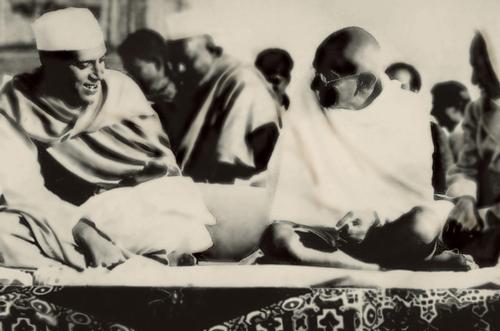 Ghandi and Nehru, IndiaPhoto: Public domain
Ghandi and Nehru, IndiaPhoto: Public domain
In 1930, Gandhi was appointed leader of a new campaign against the government's salt monopoly by Pandit Jawaharlal Nehru, the President of Congress. In 1931, Gandhi participated on behalf of Congress in a round table conference in London on the future of his country. This conference yielded the "Government of India Act", actually no more than a cloth for the bleeding.
In World War II, a majority of Congress wanted to support the British in exchange for post-war independence. The British refused to accept this and Congress launched the "Leave India" action, which only resulted in the arrest of the leader of the action.
India independent, Pakistan secedes
After the war, the British nevertheless concluded that India's colonial status could no longer be maintained. However, the transfer of sovereignty was not so smooth due to the contrasts between Hindus and Muslims. At the time, Congress was dominated by Hindus who were in favor of an independent state for all Indians. The Muslim league led by Jinnah wanted its own Muslim state, Pakistan. In 1946, the country was divided into two states, India and Pakistan. The transfer of sovereignty took place on August 15, 1947 (Indian Independence Act), from which time Hindu India and Muslim Pakistan were two independent states. They both remained with the Commonwealth, and Lord Mountbatten acted as Governor General on behalf of Britain. Prime Minister of India became Congress leader Nehru. Independence was the signal for major migrations. Pakistan was overrun by Muslim refugees from India and India by Hindus from Pakistan. Problems mainly arose in the Indian state of Punjab and the Pakistani Bengal. In the end, millions of refugees clashed and about half a million deaths were counted.
At that time, there were about 500 principalities in India who joined India or Pakistan and maintained a high degree of independence. A problem arose from the wavering attitude of the Hindu prince of the predominantly Muslim Kashmir. Pakistan intervened militarily and the Indian reaction to this led to an Indian-Pakistani war in 1948. The United Nations intervened and arranged a truce, but the Kashmir issue would still govern the relationship between India and Pakistan to this day. On January 10, 1948, a shock went through the world when Gandhi was murdered. Mountbatten resigned on June 21, 1948. On January 26, 1950, the republic was proclaimed in New Delhi and the constitution was adopted.
In the 1950s, Nehru's India was able to mediate in the Korea conflict and the first Vietnamese war (Geneva Conference, 1954). Nehru refused to form a 'third neutral block', but India had an important voice in the United Nations between 1950 and 1960.
Period Indira Gandhi
In the early 1960s, India severely clashed with neighboring China. Both China and India claimed parts of Ladakh and eventually a Chinese invasion followed in 1962.
Regarding domestic politics, Nehru had many problems to solve with various States and the precarious economic situation. In 1961 India had permanently occupied the Portuguese areas of Goa, Daman and Diu (recognized by Portugal in 1974).
Nehru died in 1964 and was succeeded by Lal Bahadur Shastri, who immediately went to war with Pakistan over the wetland province of Rann van Kutsch and the Kashmir issue. In 1965, a second Pakistani-Indian war broke out, again questioning the status of Kashmir. The mediation by the Soviet Union led to the Tashkent armistice in January 1966. Shastri died on January 11, 1966 and the new prime minister became Indira Gandhi, the only daughter of Nehru and not related to Mahatma Gandhi. However, she did become the leader of a country facing major economic and social problems. In addition, a great famine broke out under her rule.
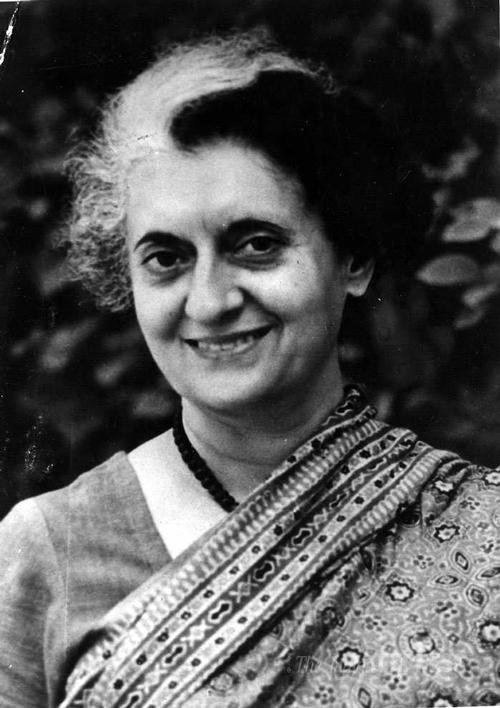 Indira Ghandi, IndiaPhoto: Anil 946 CC 4.0 International no changes made
Indira Ghandi, IndiaPhoto: Anil 946 CC 4.0 International no changes made
In 1971, a third war broke out between India and Pakistan over the Kashmir issue. The 1971 elections were won by the Gandhi Indian National Congress due to its promise to end poverty. She became extra popular through the intervention of India in East Pakistan, where the independent state of Bangladesh was declared in December. All conflicts with Pakistan and China pushed India towards the Soviet Union, especially after China and the United States supported Pakistan. In 1971 India signed a treaty of friendship with the Soviet Union.
In the early 1970s, Indira Gandhi's popularity rapidly declined due to her authoritarian style of government and cases of corruption. The absence of land reforms promised by Indira Gandhi also led to mounting tensions in the states and undermined confidence in her party. In 1973-1974, five federal states were placed under presidential rule. To enhance India's prestige, the first underground nuclear bomb was detonated in 1974. In May 1975, Sikkim was annexed and declared a federal state. In order to gain more support, Gandhi confidently called new elections in 1977, which turned out to be disastrous for her Indian National Congress. A government call for forced sterilization to halt explosive population growth was also to blame for the election defeat.
The Janata party led by Morarji Desai now came to power (Prime Minister Charan Singh), a coalition of opposition parties. Without a good political program, the chaotic situation in India grew rapidly and it was not surprising that in the 1980 elections Indira Gandhi again gained a victory and became Prime Minister for the second time. In this new period of government, various ethnic conflicts arose again, especially in North and Central India.
Serious disturbances occurred particularly in Punjab, the home of the Sikhs. The Sikh majority felt disadvantaged and economically drained by the central government, without getting anything in return. The moderate Sikh party demanded self-government, more money and a number of things of a religious nature. Radical Sikhs even demanded an independent state called Khalistan. They enforced their claim through acts of terror against the Hindu middle class and later against all Hindus and even moderate Sikhs. The Golden Temple in Amritsar was the stronghold of the extremists and this temple was stormed by the Indian army on June 6, 1984, on the orders of Indira Gandhi. About 1,500 people, including many Sikhs, were killed in the fighting. This action indirectly cost Indira Gandhi her life: on October 31, 1984, she was murdered by two of her own Sikh bodyguards.
In response, the anger of the population turned to the Sikhs, and in New Delhi alone, 3,000 Sikhs were murdered. On November 13. 1984 the new prime minister announced general elections for December 24. Rajiv Ghandi's Indian National Congress victory was overwhelming (80% of seats).
Period Rajiv Gandhi
Indira Gandhi was succeeded as prime minister by her son Rajiv Gandhi. He became a beloved leader but he also failed to achieve reconciliation with the Sikhs, despite his willingness to be flexible towards separatists. An agreement was still made with the Akali Dal party - Punjab agreement - but the unrest and attacks continued and in 1986 Rajiv only just escaped an attack.
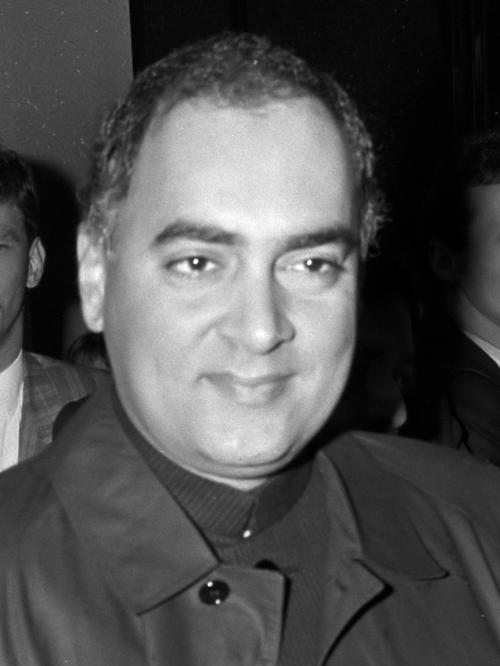 Rajeev Ghandi, IndiaPhoto: Bart Molendijk / Anefo CC 3.0 Netherlands no changes made
Rajeev Ghandi, IndiaPhoto: Bart Molendijk / Anefo CC 3.0 Netherlands no changes made
In the November 1989 elections, Rajiv Gandhi's Indian National Congress suffered a disastrous defeat as a result of a corruption scandal. Gandhi was relieved by V.P. Singh as prime minister of a minority government consisting of the Janata party, the right-wing Hindu party Bharatiya Janata (BJP) and the communists. However, Singh was also constantly confronted with ethnic violence in the Punjab, in Uttar Pradesh and of course Kashmir. At the end of 1989, an armed uprising by militant Muslims demanded secession from India in Kashmir. After only one year of government, the Singh government fell over the construction of a controversial Hindu temple in Ayodhya in November 1990, and the BJP eventually toppled the government.
Violence during the new elections bottomed out with the assassination attempt on Rajiv Gandhi. The perpetrator was a female member of the militant Tamil Tigers, whom Gandhi considered a traitor for his involvement in the civil war in Sri Lanka.
Period Rao
The elections were won by the Indian National Congress, but without a majority. Once again, they were forced to form a minority government led by the new Prime Minister P.V. Narasimha Rao.
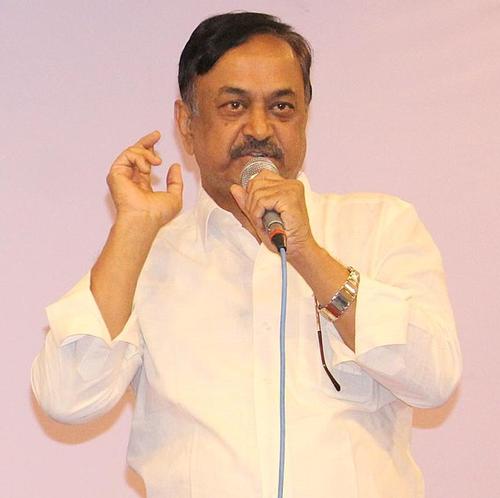 P.V. Narasimha Rao, IndiaPhoto:Pranayraj 1985 CC 4.0 International no changes made
P.V. Narasimha Rao, IndiaPhoto:Pranayraj 1985 CC 4.0 International no changes made
Under Rao rapid economic growth followed by liberalization. As a result, foreign investment rose sharply. For the poor section of the population, however, the situation hardly improved as subsidies were abolished and inflation kept rising.
Meanwhile things got a bit quieter in the Punjab, but Kashmir remained a minefield. At the end of 1992, the issue about the Rama Temple arose. Hindu fundamentalists stormed the Babar Mosque, which was completely destroyed and replaced by a Hindu temple. Then evrything escalated completely and thousands of Hindus and Muslims were killed across India. An earthquake in September 1993 killed more than 20,000 people.
Period Vajpayee
The big loser in the May 1996 elections was the ruling Congress party. After the BJP and the United Front, the party finished in third place, the worst defeat in the party's existence. Once again, there was another corruption scandal that harmed the Indian National Congress and caused ex-Prime Minister Rao to step down as President of the Indian National Congress. Especially the poor, who did not profit from the economic boom, did not vote for the Indian National Congress. The United Front, with Prime Minister Deve Gowda, again formed a minority government with the support of the Congress party. Just over a year later, that same Congress party overturned the government. In March 1998, President Narayanan, the first "untouchable" president, asked the leader of BJP nationalist Hindu party Atal Behari Vajpayee to form a new cabinet.
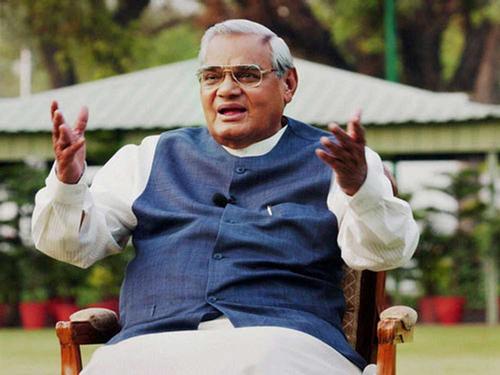 Vajpayee IndiaPhoto: Deccan Herold (CC BY 2.0) no changes made
Vajpayee IndiaPhoto: Deccan Herold (CC BY 2.0) no changes made
Kesri stepped down as the leader of the Indian National Congress in March 1998 in favor of Sonia Gandhi, widow of Rajiv Gandhi. Also in March 1998, Pakistani Prime Minister Nawaz Shamir called on his Indian colleague Vajpayee to resume dialogue between the two countries. Repeatedly the government promised to continue its liberalization policy, but most laws and privatizations were held back by the strong left wing in parliament.
On 11 and 13 May 1998, India conducted five underground nuclear tests in the Rajasthan desert. The nuclear tests were preceded by militant language towards China and Pakistan. The supporters of the government supporters did not last long. Pakistani nuclear tests a few weeks later put an end to Indian superiority, and the sanctions promulgated by Western countries prompted India to sign the Nuclear Test Ban Treaty in late 1998.
After the nuclear tests, relations between India and Pakistan deteriorated further, despite talks to improve relations. The first visit by an Indian Prime Minister to Pakistan in ten years also marked the start of the first direct bus connection between the two countries, when Prime Minister Vajpayee followed his first bus ride from Delhi to Lahore with his entourage as honorary passengers. At the subsequent summit meeting with Pakistani Prime Minister Nawaz Sharif, it was agreed to take measures to reduce the risk of nuclear weapons accidents.
The September / October 1999 elections were won by the National Democratic Alliance (NDA), a new coalition of fourteen regional, Hindu and secular parties led by the BJP.
21st century
On January 26, 2001, an earthquake measuring 7.7 on the Richter scale struck Western India. The epicenter was at Bhuj, a city in Gujarat. More than 300 villages in the area were razed to the ground and the entire state was severely affected. More than 20,000 people died and even more people were left homeless.In 2001 the Vajpayee government was chased by a number of financial and corruption scandals and in the early months of 2002, the BJP suffered significant losses during four state elections. In February-April 2002, serious religious disturbances between Hindus and Muslims occurred in the state of Gujarat, killing approximately 2,000 people, mostly Muslims, and displacing 140,000.
In the state of Jammu & Kashmir, state elections were held in four phases in late September / early October. The preceding period was accompanied by a lot of violence, including about 400 deaths. The incumbent government of father and son Abdullah, the National Conference, lost heavily, but remained the largest party in parliament. The Indian National Congress and the People's Democratic Party formed a coalition government. At the beginning of July, some important changes were made to the national cabinet to strengthen the position of the BJP. On July 15, 2002, the Muslim A.P.J. Abdul Kalam was elected new President of India.
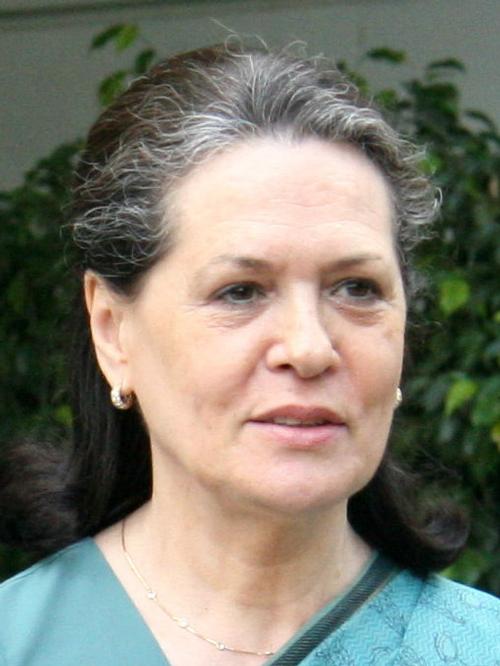 Sonia Ghandi, IndiaPhoto: Public domain
Sonia Ghandi, IndiaPhoto: Public domain
The May 2004 parliamentary election was surprisingly won by the Indian National Congress of Sonia Gandhi, the widow of assassinated former Prime Minister Rajiv Gandhi. Prime Minister Vajpayee of the coalition government resigned and his decision to advance the elections by six months turned out to be disastrous.
The Indian National Congress (145 seats) and its allies (72 seats) together with the left parties (61 seats) took 278 out of 543 seats. Vajpayee's Bharatiya Janata Party won 183 seats and other small parties and independents reached 69 seats. In total, 380 million people voted. To everyone's surprise and dismay, Sonia Gandhi quickly announced that she did not accept the premiership. In protest of Gandhi's refusal, all members of the party's central committee resigned. Gandhi, however, insisted, reportedly fearing an assassination attempt on her life and her Italian origins had prevented her from accepting the position.
The Indian National Congress then pushed forward 71-year-old technocrat Manhoman Singh, who took up the post and became India's new prime minister, while Sonia Gandhi remained as party leader. Singh promised, among other things, that he would maintain the existing economic reforms and called on investors not to abandon the land. He also pledged to make peace with neighboring Pakistan a priority and thereby indicated that he wanted to follow the path taken by his predecessor Vajpayee and Pakistani President Musharaff.
On Boxing Day in 2004, many countries, including India (especially Tamil Nadu province), in southern Asia were hit by a massive natural disaster. A seaquake occurred with a magnitude of 9.0 on the Richter scale. The quake's epicenter was off the west coast of Sumatra, near Aceh province. The quake created a wall of water that washed over the coast of India and many other countries. The waves of this so-called tsunami reached a height of ten meters in some places. In total, more than 125,000 were killed, including more than 15,000 in India.
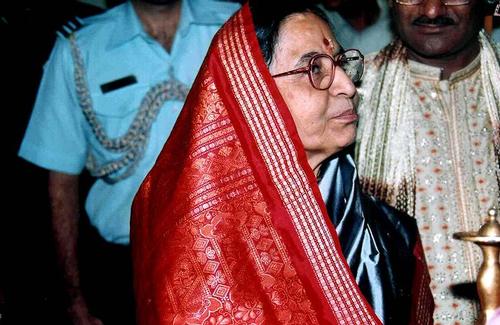 Pratibha Patil, IndiaPhoto: Jaisigh Rathore CC 2.5 Generic no changes made
Pratibha Patil, IndiaPhoto: Jaisigh Rathore CC 2.5 Generic no changes made
In July 2007, Pratibha Patil became the first woman to be elected President of India. The period 2005 to 2008 is characterized by a lot of violence and bomb attacks by extremists. In November 2008, attacks were carried out near Mumbai with more than 200 deaths. In May 2009, the Congress party of Prime Minister Manmohan Singh wins the elections and almost wins the absolute majority. In May 2010, the only surviving attacker in Mumbai is convicted. In July 2012, Pranab Mukherdee is elected as the 13th President of India.
In December 2012, India was startled by a brutal rape case that caused the victim's death. Relatively much sexual violence takes place in India. The government is afraid that fewer female tourists will visit India. In September 2013, the perpetrators were sentenced to death.
In May 2014, Narendra Modi of the Hindu nationalist Bharatiya Janata Party wins the parliamentary elections by force majeure. In the years 2015 and 2016, India was negative in the news due to a number of gang rapes. In July 2017 Ram Nath Kovind becomes president, it is special because he is of a low caste. In 2019, leaked government documents show unemployment is rising at 6.1%, the highest rate since India began reporting these figures. Clashes with Pakistan are the result of an attack by extremists on the convoy of security forces in India-administered Kashmir. In 2020 and 2021 millions of inhabitants of India were infected with the Covid-19 virus.
Sources
Boon, H. / India : mensen, politiek, economie, cultuur
Koninklijk Instituut voor de Tropen/Novib
Caldwell, J.C. / India
Chelsea House
Chatterjee, M. / India
Dorling Kindersley
Dunlop, F. / India
Van Reemst
Nicholson, L. / India
Kosmos-Z&K
Peterse, L. / India
Gottmer/Becht
Srinivasan, T. / India
Times Books
Te gast in India
Informatie Verre reizen
CIA - World Factbook
BBC - Country Profiles
Last updated June 2025Copyright: Team The World of Info